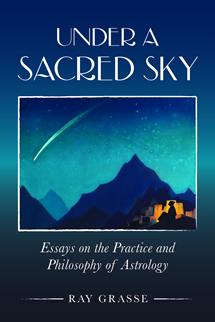Those who have studied astrology know that it works, but over the millennia, no physical or causal principle has been discovered that explains exactly how astrology works. Most modern astrologers have given up on cause-and-effect models and turned to a synchronistic or acausal explanation as defined by Carl Jung. Astrologer Ray Grasse takes this view one step further by showing how the mechanism of astrology is symbolism. “Celestial events not only connect acausally with earthly happenings,” he writes, “but also incorporate dimensions of symbolism and meaning beyond surface appearances.” An entire book could be written about this subject, but it’s boiled down to one tightly written essay contained in Ray Grasse’s Under a Sacred Sky, a marvelous collection of 18 essays he’s had published over the last twenty years.
In this first essay, titled “Symbolism, Synchronicity, and the Astrological Worldview,” he gives several clear illustrations of why the causal mechanism for astrology doesn’t work. One of the best is the Mercury retrograde phenomenon which, when it’s in effect, tends to complicate business contracts, stall communications, and make technological snafus. Yet Mercury doesn’t actually go backwards in its orbit; it’s an illusion based on the relative positions of the Earth and Mercury. Mercury emits no backward emanations that could cause these well-known, episodic mishaps. Each essay is a treasure within itself, readily understood by beginners, yet bringing insights and lessons for professionals. Numerous books have been written about Saturn, but this harsh task master is difficult to fully grasp. Does it always bring problems? One of the most practical essays in Grasse’s collection is called “Saturn, the Late Bloomer.” Once the astrologer has grasped the role of Saturn in the chart, everything else falls in place. This essay focuses on Saturn’s aspects to each of the traditional planets. For example, the Saturn-Moon aspect is referred to as “the struggle to relate.” This aspect can bring serious inhibitions in forging emotional bonds. The same aspect also bestows amazing gifts, which take a while (a long time) to develop, if one has the will and patience.
Grasse’s essays are wide-ranging, aimed at both individual practices as well as presenting a persuasive and lucid philosophical view. “The Seven Most Common Mistakes Made by Astrologers” should be required reading for anyone wanting to do consultations or readings for clients. “Astrology and the Chakras” describes the one-to-one correspondence between the planets and the chakra system. And perhaps half of these essays, in one way or another, describe how we are on the cusp of the Age of Aquarius, and leaving the Age of Pisces behind. The most direct explanation of this new age we’re entering is found in the essay “The Dawn of Aquarius.” Here, readers see how the Pisces symbols have pervaded civilization for the last 2,000 years, and the symbols associated with Aquarius are beginning to shape human evolution. The most obvious of these is the internet, while perhaps the most widespread shift can be seen in how science has replaced religion as the dominant paradigm. The messages associated with our times, which often involve the clash between the waning Age of Pisces and the incoming Age of Aquarius, are most clearly seen in the movies.
Three essays explore the planetary symbols found in cinema, and include the clash between the entrenched ways of the past, and the rebellious, high-tech wave of the future. Perhaps the clearest example is Star Wars, which is patterned after the American Revolution: a ragtag federation of rebels takes on the Evil Empire and its tyrannical leader, either King George III or Darth Vader. In this example, astrologers learn how America’s destiny is closely tied into leading the world into the Age of Aquarius.
One of the concluding essays is an interview with one of astrology’s leading lights, Richard Tarnas. The interview was conducted just before his game-changing book Cosmos & Psyche was published in 2006. Those who own a copy of Cosmos & Psyche know that it’s a superb treatise on the correlation between the evolution of human consciousness and the outer planet cycles, but perhaps have not read the whole book because it’s so long and tedious. In Grasse’s interview, the book is concisely summarized, plus we get a surprising appraisal of Tarnas’ first major book, Passion of the Western Mind, which is a bestseller within the academic system. Tarnas reveals that this history of human thought was just a Trojan Horse so he could introduce astrology to university students.
Perhaps you have come across one or another of Ray Grasse’s articles in various astrology magazines, and have noticed that he is one of those rare hybrids: an exceptionally talented astrologer and a gifted writer. Under a Sacred Sky brings his best articles together under one cover, and it’s a gem to be treasured for years. As you read his work, and share his ideas and perspectives, you will be facilitating the advancement of astrology.
Chris Lorenz - Dell Horoscope
